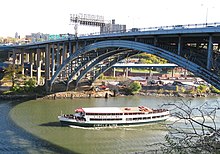Tourism in New York City includes nearly 47 million foreign and American tourists each year. Major destinations include the Empire State Building, Ellis Island, Broadway theatre productions, museums such as the Metropolitan Museum of Art, and other tourist attractions including Central Park, Washington Square Park, Rockefeller Center, Times Square, the Bronx Zoo, South Street Seaport, New York Botanical Garden, luxury shopping along Fifth and Madison Avenues, and events such as the Tribeca Film Festival, and free performances in Central Park at Summerstage and Delacorte Theater. The Statue of Liberty is a major tourist attraction and one of the most recognizable icons of the United States. Many New York City ethnic enclaves, such as Jackson Heights, Flushing, and Brighton Beach are major shopping destinations for first and second generation Americans up and down the East Coast.
New York City has over 28,000 acres (110 km2) of parkland and 14 linear miles (22 km) of public beaches. Manhattan's Central Park, designed by Frederick Law Olmsted and Calvert Vaux, is the most visited city park in the United States. Prospect Park in Brooklyn, also designed by Olmsted and Vaux, has a 90 acres (36 ha) meadow.Flushing Meadows-Corona Park in Queens, the city's third largest, was the setting for the 1939 World's Fair and 1964 World's Fair.
New York's food culture, influenced by the city's immigrants and large number of dining patrons, is diverse. Jewish and Italian immigrants made the city famous for bagels, cheesecake and New York-style pizza. Some 4,000 mobile food vendors licensed by the city, many immigrant-owned[clarification needed], have made Middle Eastern foods such as falafel and kebabs standbys of contemporary New York street food. The city is also home to many of the finest haute cuisine restaurants in the United States.
Sporting events are also tourist events. Major venues include Yankee Stadium, Citi Field, and Madison Square Garden. Street fairs and street events such as the Halloween Parade in Greenwich Village, and New York Marathon also attract tourists.
Industry
Tourism in New York City is a large industry. According to NYC & Company (the official destination marketing organization for the city of New York), the top producing countries for international visitors to New York City in 2005 were the United Kingdom (1,169,000), Canada (815,000), Germany (401,000), Japan (299,000), Italy (292,000), France (268,000), Ireland (253,000), Australia (235,000), Spain (205,000), Greece (148,000), and the Netherlands (147,000).
Unlike many other destinations, New York City does not have a distinctive tourist season. With the exception of slight peaks around Thanksgiving, Christmas and New Year's, visitor arrival rates are roughly the same year-round. New York also has one of the highest hotel-occupancy rates in the country. Arrivals have remained relatively high even since the global economic crisis, due to heavy discounting and value-added pricing.
Spearheading the city's tourism efforts is NYC & Company, the city's official convention and visitor bureau currently headed by George Fertitta. It has offices in 14 countries, including Argentina, Britain, France, Germany, Ireland, Italy, Mexico, The Netherlands, Russia, Spain, Sweden, Japan, Korea and China. NYC & Company is the official source of tourism statistics for the city. The research department develops and distributes comprehensive information on NYC domestic and international visitor statistics and monitors the travel industry's impact on New York City's economy. The department also produces 14 official New York City tourism marketing publications that feature information on member hotels, museums, attractions, theaters, stores, restaurants, meeting venues, and service providers.
Double decker tour buses and boats with tour guides bring sightseers to various parts of Manhattan and other boroughs, while pedicabs and horse cabs serve those with a taste for more personal service. More adventurous tourists rent bicycles at neighborhood shops or along the Hudson River Greenway or simply walk, which is often the quickest way to get around in congested, busy commercial districts and always the best way to appreciate street life.
Many visitors investigate their genealogy at historic immigration sites such as Ellis Island and the Statue of Liberty. Other tourist destinations include the Empire State Building, for 41 years the world's tallest building after its construction in 1931, Radio City Music Hall, home of The Rockettes, a variety of Broadway shows, the Intrepid Sea-Air-Space Museum, housed on a World War II aircraft carrier, and city landmarks such as Central Park, one of the finest examples of landscape architecture in the world. New York City has encouraged tourist shopping by eliminating its sales tax on clothing and footwear.
The World Trade Center was an important tourist destination before the September 11, 2001 attacks, which devastated the city and its tourist industry. Tourists were scarce for months, and it took two years for the numbers to fully rebound with fewer international, but more domestic visitors, due in part to an emphasis on "patriotic tourism". The World Trade Center site itself became an important place to visit.
mportant place to visit.
New York City Tourism Statistics
(source:wikipedia)







